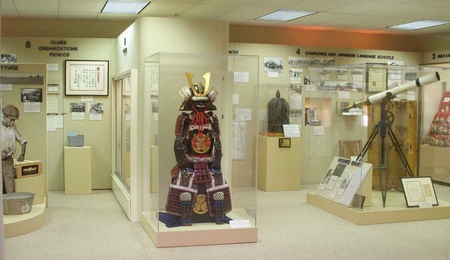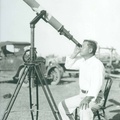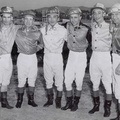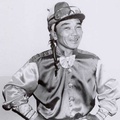Were there samurai in the Imperial Valley? The answer is yes, but that’s not why a suit of samurai armor is on display in the Imperial Valley Pioneers Museum. For those of you who have not been to the Pioneers Museum in Imperial, California, it is one of the few multi-ethnic museums in the country. Multi-ethnic themes are not uncommon, but typically museums will host one ethnic exhibition at a time, and then rotate different ones in and out.
The Pioneers Museum, on the other hand, has fifteen different ethnic exhibitions—called galleries—on permanent display. The galleries, such as the Japanese American Gallery, represent the immigrants who came from around the world and settled in the Imperial Valley over a hundred years ago. The other ethnic galleries are: African American, Chinese, East Indian, Filipino, French, German, Greek, Korean, Lebanese, Irish, Italian, Mexican, Portuguese, and Swiss.
The Pioneers Museum is owned and operated by the Imperial County Historical Society. Each ethnic gallery has its own committee that is responsible for fundraising and executing its own display. As the coordinator of the Japanese American Gallery, it is important to me that we have complete freedom in creating our respective displays. Consequently, each gallery has a little different flavor.
I believe that most of the galleries exhibit two elements: 1) the cultural heritage of their ancestral country of origin, and 2) their history in Imperial County. But they differ in how much emphasis they place on each of those two elements, whether it is equally or one more than the other. There are some galleries that have devoted nearly all of their space to displays on their ethnic homeland. I would say that 95 percent of the focus of the Japanese American Gallery is on our local history, with the caveat that Japanese culture permeates through the Nikkei experience.
The Japanese American Gallery is a 720-square foot exhibition featuring hundreds of photographs and artifacts that tell the story of the pioneering immigrants from Japan and their descendants who made the Imperial Valley their home. And if you are wondering, the first Issei who permanently settled in the area arrived in 1904.
Visitors are greeted by a life-size suit of samurai armor, albeit a replica, at the entrance of the Japanese American Gallery. A Nisei who toured the Pioneers Museum in 2014 posted this on his online blog, “I thought that the uniform of the Japanese daimyo or warlord was out of character for the Gallery inasmuch as the Gallery featured the history and legacy of the Issei and Nisei living in the Valley.” In fact, when our inaugural committee was developing our exhibition back in the early 1990s, the display of the armor was not unanimously supported. I was in favor of it, but I had to come up with a way to justify it.
The inclusion of samurai armor in the Japanese American Gallery was not exactly something that we had planned. A member of our committee was a Japanese national who owned a trading company in the Imperial Valley. He exported agricultural products such as alfalfa to Asia, and he travelled to Japan several times per year. Prior to one of his business trips he asked me what I wanted for our exhibition. I told him that I wanted a miniature suit of samurai armor for our Boy’s Day display. It was not uncommon for Nikkei families to display musha ningyo (warrior figures and miniature samurai accoutrements) for Boy’s Day, observed on May 5, and up to that point nobody had donated any original prewar pieces.
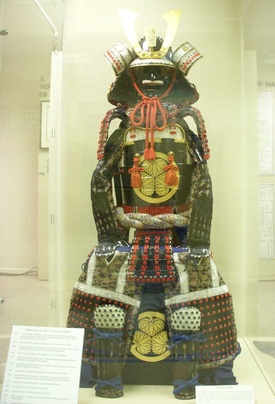
You could imagine my surprise when he returned from Japan with a life-size suit of armor! The first thing that popped into my mind was, “How in the world am I going to fit this into our narrative?”
It was just a stroke of luck that the family crest (mon or kamon) that adorns the breastplate is the aoi (hollyhock) motif of the Tokugawa family. The Tokugawas ruled Japan as shogun for nearly 270 years beginning in 1603. The bakufu (government of the shogun) issued edicts aimed at consolidating its control over the country. One of them was a policy of national isolation called Sakoku, literally meaning “locked country,” which prohibited Japanese from leaving the country, and for the most part forbade foreigners from entering Japan.
It was while the Tokugawa were in power that the United States and Japan first established official diplomatic relations. In 1853 Commodore Matthew Perry sailed into Edo Bay (present-day Tokyo Bay) bearing a letter from the president of the United States requesting that American ships be allowed to enter Japanese ports. This “opening” of Japan eventually led to the overthrow of the Tokugawa bakufu, which in turn made possible the commencement of Japanese emigration. And that is how I justified displaying the samurai armor in the Japanese American Gallery; I admit that it is a bit of a stretch!
Since then, I’ve come to realize that the armor serves additional purposes. One of the past curators of the Pioneers Museum recommended to the galleries that they display as a symbol of their cultural heritage the national flag of the country from which their immigrant pioneers originated. Almost every gallery followed suit. I think it is interesting that the Chinese Gallery displays the flag of the Republic of China and the Italian Gallery displays the flag of the Kingdom of Italy (which I had always associated with fascism but learned that it was actually adopted in the 1860s).
Because of the Nikkei experience during World War II and the persistent question of whether or not Asian Americans are accepted as true Americans by mainstream society, the Japanese American Gallery opted not to display the national flag of Japan. In our gallery, Japan’s cultural heritage is represented in part by the samurai armor.

The armor can also symbolize the significant role that samurai ideals have played in Japanese American culture from the Issei generation to the present. Have you ever heard a Japanese American state that he or she is of samurai descent? I bet you have. I’m planning to tackle this topic in a future article.
People in the Imperial Valley do not often have the opportunity to see samurai armor. Picture-taking is typically not allowed in the Japanese American Gallery, and I’ve witnessed college students from Imperial Valley College (which is located across the street from the museum) sneak selfies of themselves posing next to the armor.
In Imperial County, local history has been taught in the fifth grade. Many schools have done away with field trips due to budgetary constraints so the Imperial County Historical Society raises funds to pay for the transportation costs so that every fifth grade class in the county can visit the Pioneers Museum. The students love the armor display, especially the boys. Their eyes grow wide with excitement when they see it, and they utter a spontaneous “Wow.” I once heard one little boy call it Darth Vader!
© 2016 Tim Asamen



